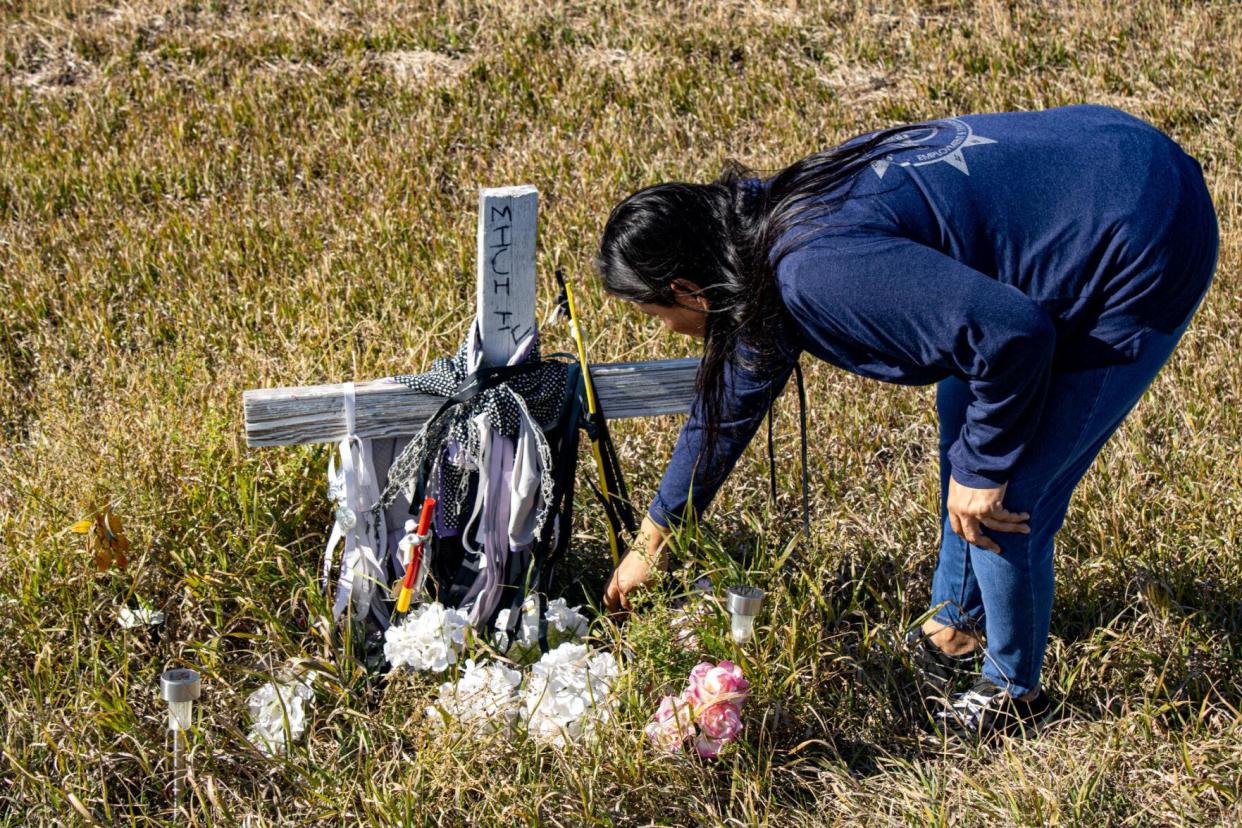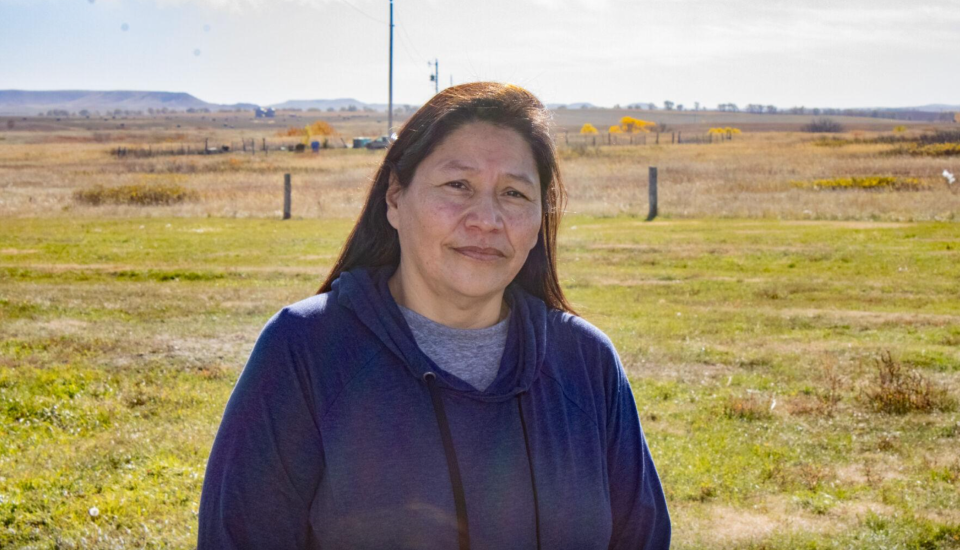Walking while Native: Indigenous people experience higher rates of pedestrian fatalities

On June 17, Ronalda Good Shield, a Crow Creek Citizen, was waiting to hear back from her daughter when she received a message that made her heart sink: “Did Micheliegh make it home?” When she heard rumblings of a woman found with a baby killed in a hit-and-run on the Rosebud Reservation, her anxiety grew worse.
“I just knew it was her, something in me told me it was her,” Good Shield said.
Around midnight, Good Shield’s daughter Micheliegh Iron Cloud was walking along Highway 63 near Parmalee. She was carrying her one-year-old son when an unknown vehicle struck her. The two weren’t found until the next day.
The baby was life-flighted to Sioux City and survived, but Iron Cloud died sometime after the crash.
Indigenous people have the highest pedestrian death rate of any ethnic group in the United States, according to the National Center for Health Statistics.
According to the United States Department of Transportation, unintentional injuries are the leading cause of death for Native Americans and Alaska Natives ages 1 to 44 and the third-leading cause of death overall. Limited access to vehicles, lack of lighting along streets, and a lack of reliable, or any, public transportation all act as barriers to Indigenous people traveling safely.
On a state level, limits on prosecution for the driver can act as a barrier to families seeking justice.
Depending on the circumstances of the crash, the driver of the vehicle can face no criminal charges at all or up to 15 years in prison if they are both intoxicated and driving negligently. If a driver leaves the scene, the highest level felony they’ll face, without the elements of negligence and intoxication, is up to two years in prison.
When a pedestrian is killed on tribal land, the Federal Bureau of Investigation (FBI) is responsible for investigating all violent crimes, often in partnership with tribal police.
The night of her death, Iron Cloud was 50 miles away from her mom’s home near Wood, S.D., and 87 miles from where she’d been staying in Sharps Corner on the Pine Ridge Reservation.
Initially, Iron Cloud had planned on sleeping at a family friend’s home, and her mother would pick her up early the next morning when she could get gas. Sometime around midnight, Iron Cloud decided she’d walk.
Iron Cloud had no other means of transportation. Her car was recently broken into and damaged and the closest gas station to her mother’s house in rural South Dakota had closed hours ago.
Iron Cloud was her family’s rock, Good Shield said. She took care of her brother who has schizophrenia. Her siblings could count on her for anything. She was outgoing and active, dancing as a fancy shawl dancer since she was a kid.
“She was always happy-go-lucky, always dancing, always happy,” Good Shield said.
At the time of her death, Iron Cloud had been working on finding her own home where she could raise her son and care for her brother.
“We still struggle, I struggle a lot,” Good Shield said. “The hardest part is not knowing what happened.”

Crashes by the numbers
Motor vehicle crashes cause an annual average of at least 655 fatalities in tribal areas, according to the United States Department of Transportation.
Many deaths on reservations are unreported, or not shown in state datasets, including Iron Cloud’s death in Todd County.
“If the FBI investigates and Tribal Law Enforcement does not submit a crash report, we will not have the report in our system,” DPS Public Affairs Specialist Steve Long said in an email. “We can only provide data on reports that have been submitted by law enforcement.”
Iron Cloud’s family said the FBI has been investigating her death since the day she was found.
In South Dakota, the total number of Indigenous people killed in hit-and-runs since 2018 is unclear. Data from the Department of Public Safety suggests 60 pedestrian deaths from 2018 to 2022. Of those deaths, 22 occurred within a reservation or in a county that overlaps with reservation lands.
Of the 60 recorded deaths, 20% occurred in Pennington County and 20% in Oglala Lakota County. Pennington County contains 12.5% of South Dakota’s population while 1.6% of South Dakotans live in Oglala Lakota County.
Following Pennington and Oglala Lakota counties is Minnehaha County, which accounts for 15% of pedestrian fatalities.
The total number of pedestrian deaths in Oglala Lakota County may be undercounted. The OST tribal police force is responsible for reporting numbers to the state. The department is underfunded, according to a 2022 lawsuit, and is unable to answer every emergency call made.
Lincoln County recorded 8.3% of fatalities in the state and Fall River County accounted for 6.7%. The remaining 21 crashes were spread out between 18 rural counties experiencing just one to two pedestrian fatalities each in the five-year span.
Family seeks legal recourse
Just after 12 a.m. on Oct. 14, 2022, Nevaeh Brave Heart, an Oglala Lakota 14-year-old, of Rapid City, and her cousin walked along North Lacrosse Street in Rapid City.
Her cousin crossed East Van Buren Street, according to law enforcement reports, and heard a noise. He turned around and saw a truck drive a short distance away and stop. He tried to wave the car down, but it continued south — braking only once. His cousin was lying in the street bleeding.
Brave Heart’s mother, Heather Bettelyoun, arrived not long after. She had been calling Brave Heart and driving around the neighborhood.
“I got that feeling that something was wrong, so I went looking for her,” Bettelyoun said.
When she arrived, Brave Heart was still alive.
“I knew the way she looked, I couldn’t save her,” she said. “I can’t believe someone could just leave her like that.”
Brave Heart — described by her mother as shy, but outgoing around family — died at the scene.
For four days, detectives searched for the person driving the vehicle.
That Tuesday police arrested 27-year-old Jordan Hare based on camera footage gathered throughout town following the suspected vehicle, which Hare is accused of driving. He is charged with hit and run resulting in death or injury, obstruction and failure to yield. His trial was scheduled to begin Nov. 13.
Hit and run resulting in death or injury is a class 6 felony with a maximum sentence of two years in prison and up to a $4,000 fine.
Obstruction is a class 1 misdemeanor with a maximum of one year in the county jail and up to a $2,000 fine. Failure to yield is a class 2 misdemeanor with a maximum penalty of 30 days in jail and up to a $500 fine.
Brave Heart’s family has said publicly they are dissatisfied by the charges that were brought against Hare.
Pennington County State’s Attorney Lara Roetzel said she could not comment publicly on the case, but she explained the various crimes someone could be charged with if they hit a pedestrian.
“We have this happen a lot of times in Rapid City where there’s just a tragic accident. There may or may not be any criminal charge at all,” Roetzel said. “Sometimes it’s a careless driving misdemeanor ticket if the person was being a little bit careless. Sometimes there’s a citation for running a stop sign. It’s usually a very, very minor traffic infraction.”
Roetzel recalled cases where mourning families have not wanted to pursue a traffic ticket because it felt like an “insult” to the death of their loved one.
If someone flees the scene though, there’s the hit-and-run statute Hare is charged under.
There’s also charges of vehicular battery for injuries and vehicular homicide. Vehicular battery has a maximum penalty of 10 years in prison and a $20,000 fine. Vehicular homicide has a maximum penalty of 15 years in prison and up to a $30,000 fine.
For both statutes, the state has to prove four elements — the person drove negligently, the driver was under the influence of some substance, the negligent driving of the vehicle was the proximate cause of the death or injury, and the person didn’t mean to cause the death or injury.
“It’s not enough that the person be intoxicated,” Roetzel said. “In addition to the intoxication, they have to be driving negligently.”
If someone leaves the scene after hitting a pedestrian, investigators may not be able to determine if they were intoxicated at the time, leaving hit and run with death or injury as the only charge specific to the crash.
In cases where there is a low-level crime, families will support a ticket or misdemeanor to provide support for a civil case, Roetzel said.
Bettelyoun is pursuing a civil case against both Hare and his employer for the death of her daughter.
The lawsuit claims Hare was on an errand for work at the time of the crash, which makes McDonald’s Corporation and E & N Street LLC liable for his alleged actions.
The Journal reached out to Jack Hieb of Richardson, Wyly, Wise, Sauk & Hieb LLP in Aberdeen. The firm represents both companies. Hieb declined to comment on the pending litigation.
Hare’s attorney did not return a request for comment.
According to the lawsuit, Hare had just given a coworker a ride home before Brave Heart’s death. The investigation is ongoing. Bettelyoun’s attorney, Robin Zephier, said Hare is not available to answer questions under oath because his criminal case is pending.
“Anytime you lose a life, especially a young beautiful girl at 14, the world ahead of her, any human being would want to seek something,” Zephier said.
“Hopefully that’s not the only justice we get,” Bettelyoun said.
Brave Heart’s crash report is one of two listed as unsolved with the state.
In Oglala Lakota County, the Dec. 6, 2021, hit-and-run death of 13-year-old Eternity Flying Horse in Pine Ridge remains unsolved. Flying Horse and her niece left the store and began to walk back to her sister’s house when Flying Horse was struck and killed by an unknown vehicle.
Few details are available about Flying Horse’s death or the status of the investigation.
Limits to transportation
In many reservation communities, walking is the only way for someone without a car to travel.
While the Rosebud Transit system is available on the Rosebud Reservation, trips must be booked two days in advance. As of 2018, a round-trip ride to Rapid City cost a flat rate of $100, and a round-trip ride to Sioux Falls was $150.
The bus doesn’t operate on Sundays, the day Iron Cloud needed a ride out of Parmalee.
In Oglala Lakota County, 10% of households do not own a car, as opposed to a 4% rate nationwide. Additionally, 10% of the population walks to work, with an average commute of about 20 minutes.
The Cheyenne River Sioux Tribe offers a bus route with stops in 24 different villages from Eagle Butte. All trips depart sometime between 5:30 and 8:30 a.m. depending on route. Trips are also available to Rapid City and Pierre for medical purposes upon request.
Even off reservation transportation can be an issue.
In Rapid City, the Rapid Transit System operates from 6:20 AM through 5:50 PM Monday through Friday. The weekday Dial-A-Ride hours are the same. Rideshare options like Lyfts are available but can be pricey.
Many places on the North Side lack lighting, including the intersection where Brave Heart was hit.
Initiatives to improve roadway safety
In response, tribes and government agencies have taken steps to improve roadway safety and public safety.
In July, the U.S. Department of Transportation announced $20.9 million in grants aimed at improving road safety on reservations, 13 of the grants went to South Dakota tribes.
In September 2023, Transportation Secretary Pete Buttigieg visited South Dakota to meet with representatives from all nine tribes. He spoke about the different transportation needs of their communities, including frequent pedestrian deaths.
The Flandreau Santee Sioux Tribe, Oglala Sioux Tribe, Crow Creek Sioux Tribe, Cheyenne River Sioux Tribe, Sisseton Wahpeton Oyate, Yankton Sioux Tribe and Rosebud Sioux Tribe all received various amounts of funding for public safety projects.
In June, the Crow Creek Sioux Tribe announced plans to increase roadway safety for both drivers and pedestrians by installing extra lighting and announcing a plan to build a traffic circle in Fort Thompson. The tribe claimed the traffic circle will reduce pedestrian hits by 40%.
Chairman Peter Lengkeek said several tribal members have been struck while walking, fortunately, many have survived. Buffalo County, which encompasses Crow Creek, reported two pedestrian crash deaths in the past five years.
Earlier this year, the tribe installed new solar-powered lighting outside of Fort Thompson beside the sidewalk along BIA Route 4.

Moving forward
It’s been over a year since Iron Cloud’s death, and her family still doesn’t know exactly what happened that night.
Iron Cloud’s son is now two years old. He made a full recovery from his injuries and is happy and healthy, Good Shield said. He’s learning to talk, sing and grass dance with the help of his uncle and cousin.
In September, the FBI announced a $10,000 reward for information leading to the arrest and conviction of anyone responsible.
Every day is a struggle, Good Shield said, but the family is pushing through.
Anyone with information about Iron Cloud’s death can contact the FBI’s Minneapolis Field Office at 763-569-8000. The tip line is open 24/7.
Information can also be submitted at tips.fbi.gov.
This article originally appeared on Sioux Falls Argus Leader: Indigenous people experience higher rates of pedestrian fatalities
